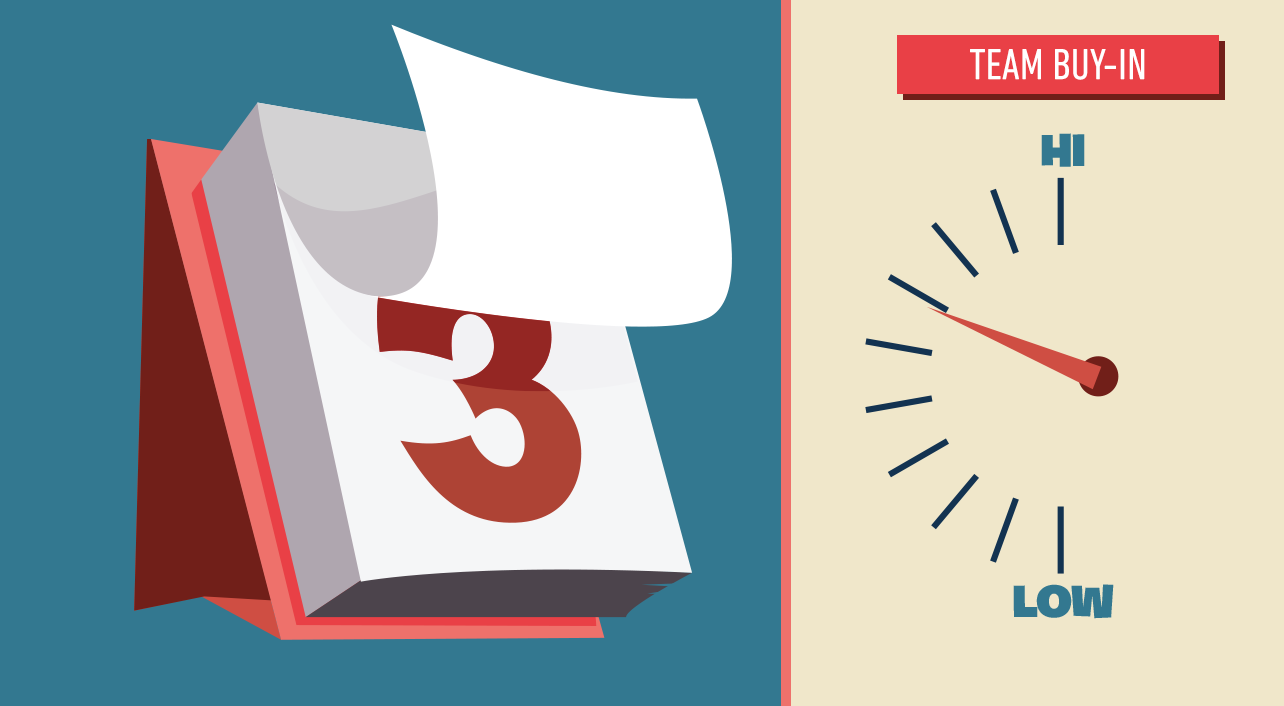- leadership
- Blog post
When it comes to getting buy-in for change, timing is everything
Some employees are excited by the prospect of change. But most aren’t, and when you have to introduce necessary change in your team or department, you want to give yourself the best chance of bringing the laggards along with you.
A critical part of any potentially disruptive change is the timetable. You could:
- Make the change effective immediately and follow up to make sure it sticks, or
- Announce the change, but phase it in gradually over several weeks, or
- Announce the change, but tell people it won’t take effect for a couple of months
Which is best?
Well, according to research from Harvard Business School and elsewhere, you’re mostly likely to gain buy-in with the third option – introducing the change but delaying its implementation. Behavioral psychologists call this phenomenon “future lock-in,” and it helps employees see change in a much more positive light.
Different views of the future
The Harvard researchers did an experiment to see how time affected people’s feelings about change. They asked subjects if they’d support higher fuel prices to improve the environment. When told that the price hike would happen immediately, only 26% were in favor. However, when told that the hike wouldn’t take effect for a few years, buy-in increased to 41%.
In another study, an economist at the Stockholm School of Economics explored “future lock-in” in the real world, with real money. She asked 1,000 people who were making monthly charitable donations if they would increase their giving. Half were asked to do it immediately; the other half were told that the change wouldn’t take effect for a month. The ones who were granted a one-month delay were more likely to increase their monthly donations. And on average they gave 32% more money.
So why does delaying change increase people’s acceptance of it? Is it just that they hope the change won’t actually happen? Nope.
Psychologists say it’s because people evaluate near-future and distant-future events differently. People see the near-future in very concrete, detailed terms. And when it comes to change, people who are thinking near-future tend to focus on the costs. For example: If I go on a diet, I won’t be able to eat my favorite foods.
But when people are thinking about distant-future events, they’re more likely to focus on the benefits of change, such as: If I want to look and feel better at my high school reunion, this diet will help.
A change scenario
How would this play out in a real change situation in the workplace?
Suppose you have to rearrange your department’s schedule, requiring employees to arrive at work at 8 a.m. rather than 9 as in the past. If you make the change effective immediately, people will likely focus on the downsides: hassle of adapting to a new routine, less time to sleep in the morning, difficulty of getting breakfast before leaving for work. But if you announce the change and delay the start date a few months, they’ll be more likely to focus on positives: getting out of work before rush hour, having an extra hour of leisure in daylight to mow the lawn or play sports, and so forth.
OK, fine. But what about a middle ground, where you phase in the change over the span of, say, a few weeks? Surely that’s an appealing alternative.
You might think so. But research suggests that a gradual phase-in is actually the worst option. Change that happens slowly can be excruciating, creating a lengthy period of confusion and anxiety. Also, employees may conclude you’re not committed to the change and are just testing it out, which opens up the potential for a lengthy debate throughout the roll-out period.
In the final analysis, you may not always be able to time change perfectly. A change may be urgently needed, and you have to make it effective right away. Or the change may be coming down from higher up in the organization, and you won’t be master of the timetable. But when the timing is in your hands, consider announcing the change right away and making it effective a few weeks or months later.
This blog entry is adapted from the Rapid Learning module “Communication: How to Get Buy-in for Change,” based on the following research studies:
Rogers, T. and Bazerman, M. H. (2008). Future lock-in: Future implementation increases selection of ‘should’ choices. Organizational Behavior and Human Decision Processes, 106, 1-20.
Breman, A. (2011). Give more tomorrow: Two field experiments on altruism and intertemporal choice. Journal of Public Economics, 95(11-12), 1349-1357.

Get a demo of all our training features
Connect with an expert for a one-on-one demonstration of how BTS Total Access can help develop your team.




